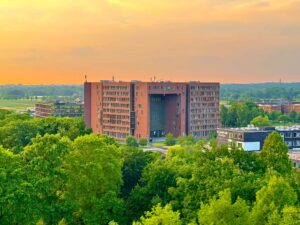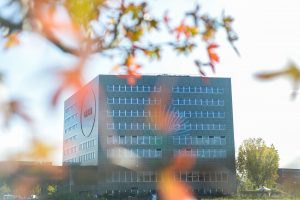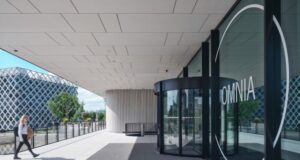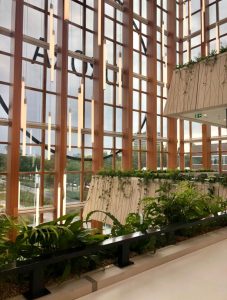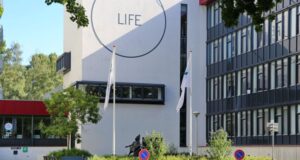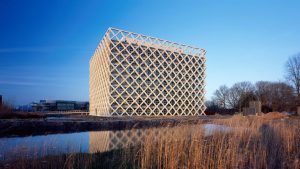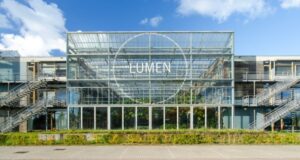Get to Know the WUR Buildings Up Close!
Hey fellow students and future WUR explorers!
As a Wageningen University & Research (WUR) student, I’ve spent countless hours wandering through the iconic buildings that make our campus one of the most vibrant and innovative in the world. Whether you’re a newbie just arriving or someone curious to learn more about your surroundings, here’s a little guide to the coolest (and most beautiful) spots on campus.
Let’s have a closer look at Forum, Orion, Axis, Omnia, Aurora, Leeuwenborch, Helix, Atlas and Lumen and discover what makes each one special!
Forum: Heart of the Campus
Forum has been at the center of student life since it opened in 2007, and you’ll see why the moment you step inside. Designed by Quist Wintermans Architecten, Forum looks like a sleek, modern castle from the outside, square and monolithic. Inside, though, it’s a whole other story. The building is full of courtyards and varied spaces, with the Agora (a lively courtyard) at its heart. Here, you’ll find a restaurant, grand café, shops, study spots, and plenty of places to meet friends and colleagues. Forum truly lives up to its name. A forum is a place for gathering and sharing ideas, exactly what happens here.
I personally spend most of my time studying in Forum. The variety of study spaces, from silent areas to open spots where you can work in groups, really suits my rhythm. Also, the cafeteria here is one of my favorites, great food and even better atmosphere.
Orion: The Star of Learning
Orion is literally a star, not just in appearance but in how it connects students and ideas. Opened on 2 September 2013 and designed by Ector Hoogstad Architecten, Orion is shaped like the Orion constellation. Cool, right? This star-shaped design promotes openness and collaboration. It features a dramatic central atrium, flexible learning spaces, and huge lecture halls that can host over 700 students. Moreover, it’s super sustainable, with energy-efficient systems that make it a green standout on campus. The star shape isn’t just for show. It symbolizes WUR’s mission to lead the way in science and innovation.
I still remember attending a lab session in Orion. And when it comes to food, the cafeteria here is another top pick for me. It’s hard not to love Orion.
Did you know that most on-campus Open Days at WUR are held in Orion? It’s no surprise, given how central and impressive this building is. Want to experience Orion for yourself? Join one of our upcoming Open Days and explore study programmes, meet lecturers, and discover what student life is like at WUR. Check out the WUR Study Orientation page for details.
Axis: The Research Core
If you’ve ever wondered where much of the behind-the-scenes science happens, it’s in Axis. Opened in 2012 and designed by Wiegerinck Architecten, Axis is a hub for departments like Animal Sciences and Food Safety. Its design is clean and functional, with transparent spaces that connect labs, classrooms, and offices. The name Axis is no accident. It reflects the building’s role as a central pivot for research and discovery on campus. Like many WUR buildings, it also incorporates sustainable features.
Omnia: The Inclusive Dialogue Center
The newest kid on the block, Omnia opened its doors on 10 May 2022 and is already making waves. Designed by Broekbakema, this stunning circular building emphasizes openness and inclusivity. Its wooden structure and green roof blend beautifully into the surroundings, making it both eco-friendly and visually amazing. Inside, Omnia hosts conferences, dialogues, and workshops. The name means “everything” in Latin, reflecting WUR’s mission to bring people and ideas together. It’s a space where science meets society and where we can come together to solve big challenges.
Aurora: The Dawn of Learning
Named after the aurora borealis and the Roman goddess of dawn, Aurora is a truly inspiring building. Opened on 30 September 2021 and designed by LIAG Architecten, Aurora is filled with natural light thanks to its huge windows and terraced floors. It’s also one of the greenest buildings on campus, with natural ventilation, solar panels, and a BREEAM Outstanding sustainability rating. Aurora aims to create an open, welcoming space for learning and collaboration, and it definitely delivers.
Leeuwenborch: The Historical Anchor
If you’re a social sciences student, you’ll likely spend a lot of time in Leeuwenborch (or, as we call it, ‘Lebo’). Opened in 1974 and designed by W.R. de Vries, Leeuwenborch is one of the older buildings on campus. However, it has been renovated to keep up with the times. The design features a central core that connects three wings, with plenty of space for lectures, libraries, and socializing. The name comes from the old Leeuwenborch neighbourhood that once stood here, linking WUR’s modern mission to its local history.
Helix: The DNA of Innovation
Now, let’s talk about Helix, one of the coolest research buildings on campus. Opened in 2015 and designed by Wiegerinck Architecten, Helix takes its name (and design) from the double helix structure of DNA. It’s a stunning building with four high atria spiralling around a central core, creating dynamic spaces for life sciences research. Helix is home to departments like Nutrition and Biomolecular Sciences. It’s packed with state-of-the-art labs and collaborative spaces. If you’re into science and innovation, this is where the magic happens.
Atlas: The Bold Vision
If you’ve ever passed the striking white lattice structure on campus, that’s Atlas, home to WUR’s Environmental Sciences Group. Opened in 2007 and designed by Rafael Viñoly, Atlas was built to impress. Its iconic exoskeleton wasn’t just for looks, it was originally meant to support climbing plants, though that idea was later dropped. Inside, the open, column-free spaces and sunlit atrium reflect its focus on transparency, collaboration, and sustainability. As a modern landmark with international design awards to its name, Atlas shows how science and architecture can go hand in hand.
I still remember the first time I saw Atlas, it looked like something out of a sci-fi movie. Bold, bright, and completely unforgettable.
Lumen: Nature Inside and Out
Lumen (Building 100) is one of the most distinctive spots on Wageningen Campus. Opened in 1998 and designed by German architect Stefan Behnisch, it was the first building constructed on the new campus. True to its name, “Lumen” means “light”, the building is filled with natural light. It features two indoor gardens that bring the outdoors in. Its E-shaped layout and use of natural materials create a calm, open atmosphere that encourages collaboration and reflection. Lumen houses several Environmental Sciences chair groups, the World Soil Museum, and the Natuurtuin (Nature Garden). It’s a peaceful place to study, meet, or just enjoy the greenery and the sound of bubbling water.
It’s also incredibly photogenic. I have tons of pictures taken in its stunning canopy and indoor garden. If you’re looking for scenic spots on campus, Lumen is unbeatable.
Each of these buildings is more than just bricks and glass they’re part of what makes WUR such a special place to study and grow. From the lively hub of Forum to the light-filled Aurora, the star-shaped Orion to the DNA-inspired Helix, these spaces reflect our university’s core values: sustainability, inclusivity, innovation, and connection with nature.
So next time you’re walking across campus, take a moment to look around and appreciate the thought and creativity behind these incredible buildings. Who knows you might just discover a new favorite study spot or inspiration for your next big idea!
Catch you around campus
Best Regards,
Devi Muralee Krishna


